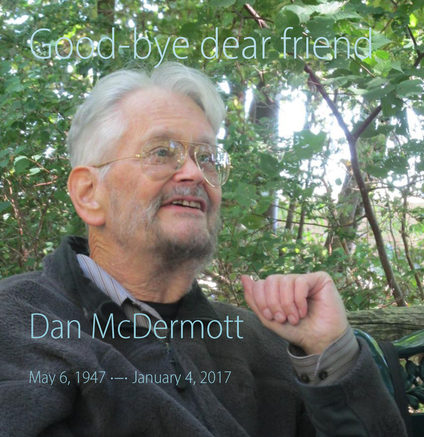


February 16th, 2017
,

Dan McDermott, Sierra Club Canada’s Ontario Chapter Director for 13 years, passed away peacefully on January 4th 2017. It is wonderful to see his influential life mentioned in these posts, which have featured in the news recently with reflections and thoughts on Dan’s life, what he dedicated it to, and his passing a month ago.

Dan will be sorely missed and fondly remembered by all those who knew him. In lieu of flowers, donations to the Sierra Club Canada Foundation – Ontario Chapter would be appreciated. We are planning a tree memorial for him at the Toronto Islands, stay tuned for more information… Read more on Sierra Club Ontario’s blog.
The following article was originally published in August 2016 on Sierra Club Canada Foundation’s blog.
At almost 2 million acres, it’s the world’s largest permanently protected greenbelt. Dan McDermott, who is just stepping down as Chapter Director of Sierra Ontario after many years, weighs in on the Greenbelt’s successes and his concerns for its future as it reaches the ten-year review point.
Dan McDermott remembers how, before the creation of the Greenbelt in 2005, he and his late wife, Helen, would head out of Toronto every spring to go hiking in the countryside, often only to find that some previously green space was now a development or a development under construction: “We almost became resigned to the situation, telling ourselves that Southern Ontario would simply become paved from end to end.”

As our world becomes increasingly crowded and urban sprawl threatens to engulf us, greenbelts are seen worldwide as one way of ensuring that critical green space, natural wilderness areas and farmland are preserved. Ontario’s Greenbelt accomplishes all this. In addition, Ontario’s decision to protect the rivers flowing into Lake Ontario should help to ensure that the province has good quality drinking water.
Of course, other Canadian cities have also developed plans to protect farmland and green space. There is the Ottawa Greenbelt, with its 203 square kilometers of protected green space within the city of Ottawa. In Montreal, a plan has been developed to protect green and natural spaces, but the plan is not backed by mechanisms to enforce it and does not have a budget. Other cities in Canada also recognize the need to protect natural spaces and halt urban sprawl. On the provincial level, both British Columbia and Quebec have enacted agriculture zones to protect farmland from development.
But the comprehensive nature of the Ontario Greenbelt and its scale make it a model for other urban areas, both inside and outside Canada, to emulate… Read more on Sierra Club Ontario’s blog.
Through a threefold series of announcements a process has been set in motion which could result in substantial reductions to the protected area of the Ontario Greenbelt. Lands included within the Greenbelt boundaries are protected from urbanization for a period of ten years. They can be removed only through a high profile provincial level examination.
On the other hand, Rural lands outside the Greenbelt in environmental or agricultural designation/zoning can be urbanized every five years through the process of the periodic comprehensive of municipal official plans. These decisions are made by municipal councils, subject to appeal to the Ontario Municipal Board (OMB). Lands taken out of the Greenbelt by municipal plan reviews can be easily paved over through piecemeal planning process. It will inevitably have harmful consequences to watersheds which are highly stressed and vulnerable to pollution through additional and ill-considered urbanization.

Photo Credit: Greenbelt Foundation website
Protecting the Greenbelt is the most effective way to safeguard vulnerable streams at risk of further ecological degradation from urbanization. These streams include the Rouge, Bowmanville Creek and the Humber. While there are close to 100 separate parcels being proposed for removal from the Greenbelt, the basic principles against removal of all of them are clear and straightforward. It is important that the province clearly hear that the removals are opposed by those who care for the watersheds and wildlife threatened by urban sprawl… Read more on Sierra Club Ontario’s blog.
Sierra Club Ontario’s Green Energy Campaign is gearing up for our interventions at the National Energy Board on Energy East and Eastern Mainline. We are looking for volunteers who are skilled in graphic design and research.
If interested, please contact our Chapter Coordinator, Yvonne Ho, at ontariochapter@sierraclub.ca
Yvonne is an environmental professional with a background in environmental science and sustainability. She has several years of work experience in the environmental non-profit sector— carrying out research on key environmental issues, writing reports and educational articles, executing membership development and outreach initiatives, as well as implementing marketing and communications plans for campaigns. She has a keen interest in renewable energy, waste reduction, circular economy, and sustainable development. Prominent not-for-profit environmental organizations she has volunteered at and worked for include Sierra Club, Environmental Defence, Ontario Sustainable Energy Association, Toronto Environmental Alliance, and Pollution Probe. Yvonne is motivated to work together with like-minded people and organizations (such as Sierra Club Ontario) towards greater environmental justice and more urgent climate action.

If you are interested in attending one or more of these meetings, please contact us at ontariochapter@sierraclub.ca to obtain more information.
Love what we do? Donate to our cause:

Sierra Club Canada Foundation
To unsubscribe from these mailings, click here
To opt out of all Sierra Club Canada Foundation mailings click here